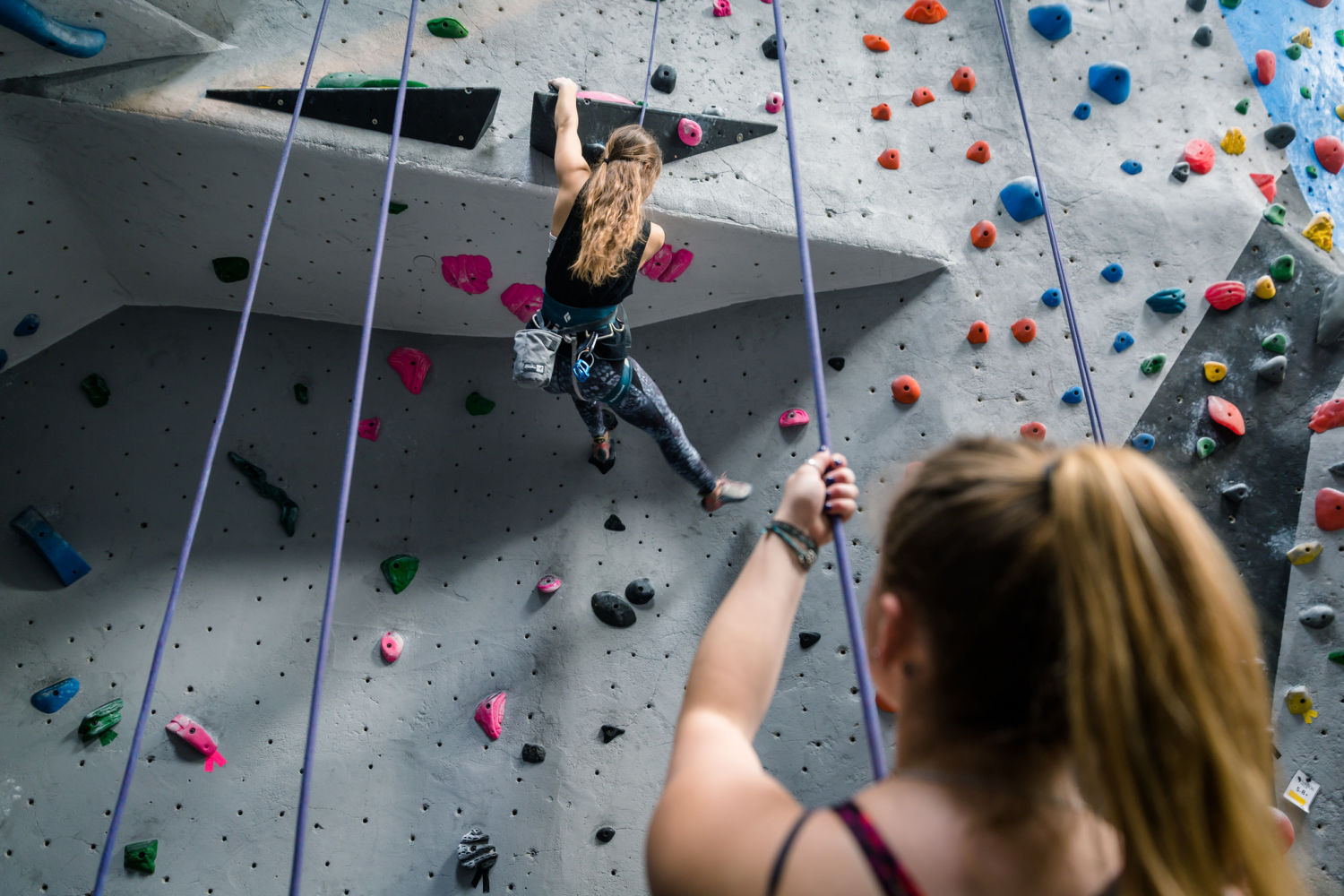You have been looking for an activity than can fetch fun, fitness, and a healthy dose of adrenaline, and you settled for rock climbing. It is a worthwhile undertaking with legions of exciting adventures, and it boosts your fitness and health. Besides, it helps you meet and connect with new friends. You may want to know how to start rock climbing, so read through my guide for more info.
How To Start Rock Climbing (Step By Step Guide For Getting Started)
Rock climbing has a host of different routes, making it important to have prior knowledge before navigating your course. Rock climbing is not a rock in the park, especially for beginners. You can transform yourself into a rock jock if you are fit and have proper equipment and training.
So, how do you get started on this fulfilling adventure? We have crucial tips to get you started in your adventure and make it more rewarding. Here are the steps towards becoming an accomplished rock climber.
For Inspiration - Best Climbing Movies Of All Time
Step 1: Get Yourself A Good Guide
You may have realized that you can do a lot of your activities at the gym by yourself. However, going to a climbing gym helps you learn how to do more activities with proper form and technique. Hitting the climbing gym allows you to get a find a guide or climbing coach.
Outdoor rock climbing also requires a qualified guide. Some folks may get in touch with their experienced family members and friends when learning how to rock climb. If you choose to get started in outdoor climbing, I recommend getting set up with a hiking or climbing group that goes on trips every month. This will greatly improve your beginner climbing experiences.
You can also reach out to local climbing gyms, clubs, or organizations for instructions. Alternatively, you can find and enroll in a climbing class to learn crucial tips. Many climbing gyms have classes dedicated to teaching beginners the basics.
Step 2: Choose Your Preferred Type Of Climbing
Rock climbing has many different disciplines with their own unique gear and types of training. An person's preferred climbing style plays a critical role in determining where they climb, what gear they use, and how they send routes. It's recommended to begin with indoor climbing, top-rope, or bouldering if you are a beginner. Here's a brief insight into some types of climbing.
Indoor Climbing
Most folks become indoor climbers by joining a climbing gym. Many public recreation centers, colleges, and REI stores have free-standing pinnacles or walls for beginners to try their rock climbing techniques. A dedicated rock climbing gym will have tons of walls, holds, and problems for beginners and advanced climbers.
These places are equipped with artificial feet and handholds of varying difficulty placed at random points to enhance learning. The route setters facilitate the efficient movement of the holds to create continuous climbs on the same pinnacle or wall. There are several benefits associated with indoor climbing, including the following;

Bouldering
This activity does not require sophisticated gear, and it takes little time. Bouldering offers unmatched climbing simplicity as most activities as many heights one can jump off comfortably. However, some advanced bouldering sessions can be a move involving.
Climbers often spend more time traversing the given area to enhance their movement and strength without exposure to possible long falls. These movements prepare individuals for tougher and more strenuous climbing activities.
Bouldering is a vital rock climbing practice because you need only climbing shoes, a crash bag, a chalk bag, and a versed spotter. The activity doesn't require a harness or rope.
Climbing gyms and organizations offer indoor bouldering, while outdoor bouldering areas are available.
Top-Rope Outdoor Climbing
Top-roping is a rock climbing art where the climber anchors the climbing rope into a specific spot at the top of the climbing route. The climber then ascends towards the anchor as a separate climber on the ground keeps the anchored rope taut.
A solid anchor point and a taut rope are essential in reducing the falling distance if you slip off the rock as you climb. Most beginners are introduced to top-rope outdoor climbing because of the reduced fall and possible danger.
The belayer is the person pulling the slack and holding the rope in case of possible falls. Belaying is a crucial role in rock climbing, making it important to have your instructor, a guide, or a trained climber as a belayer. You will also learn to become an accomplished belayer as you advance in your climbing adventure.
Outdoor Sport Climbing
This rock climbing activity involves going through routes equipped with bolts that have been drilled into the rock. Your progress is marked by using quickdraws.
Related Article - What Is Sport Climbing?
Traditional Climbing
This complex outdoor climbing activity requires you to have a mastery of the science and art of anchor placement. The trade route is characterized by few permanent anchors leaving much of the job to the climber. The lead climber is entrusted with protecting the crew against fatal falls by driving protection, camming devices, or nuts into the rock fissures. Ropes are connected to the protection using quick ways. This climbing activity is recommended if you have vast rock climbing experience.

What You Need To Start Rock Climbing
There is no need for sophisticated climbing gear if you begin your climbing spree in a gym. Most gyms offer climbing shoes, chalk, mats, and other climbing gear. However, you will graduate into an outdoor climber, increasing the need to acquire personal rock climbing gear. Some of the items you need include;
Rock Climbing Shoes
The special shoe cushions your feet from injury besides offering sufficient friction for grip. Choose snugly fitting shoes to avoid discomfort. Rock climbing shoes typically come with a more pointed toe than traditional sneakers. There are three main types of climbing shoes; neutral, moderate, and aggressive.
Neutral climbing shoes are great for beginners since they are comfortable to wear all day and don't feel vastly different from regular shoes. Moderate climbing shoes offer a slightly more downturned, or cambered, sole, which allows for better grip on small crimps and holds.
Last but not least, we have aggressive climbing shoes. These are for more advanced or sport climbers. They feature an aggressive downturn in the toe area to allow for more dynamic climbing techniques.
Climbing Helmet
Always ensure that you wear safety helmets designed for rock climbing any time you go outdoor climbing. Climbing helmets are crucial in protecting your head against possible injuries, debris, and falls. Helmets are often not required in climbing gyms because of the controlled nature of the environment.
Climbing Harness
You always require a climbing harness except when bouldering. A typical harness consists of a snugly fit waist belt over your hips and leg loops going around each leg. A harness is part of the vital protection clothing for every rock climber or mountaineer. Choose the right harness depending on your type of climbing plant.
Chalk
Chalk is essential in improving your grip, especially when you sweat, making your hands perspiration-free.
Carabiners
Another crucial component of the rock climbing gear that helps the climber connect the climbing rope to other climbing protection pieces.
Climbing Ropes
The rope is the most important rock climbing gear. Gyms and organizations that offer rock climbing for beginners provide ropes. However, you will choose a preferred rope as you advance.
Crash Pads
The climbing gear consists of dense foam pads placed under every climber to protect them from the impact of falls or jumps.
Rock Climbing Basics
Indoor Vs Outdoor
The best place for beginners to learn rock climbing is through indoor activities offered by local gyms or clubs. It is advisable to start with indoor activities in preparation for elaborate outdoor rock climbing activities.
Knots
There are different knots that climbers look forward to learning. The most common knots that can aid your climbing session include the figure-8 retraced, clove hitch, double fisherman’s, girth hitch, euro death, and Prusik knot. It is advisable to know and acquire the mastery of these knots for a more fulfilling climbing experience.
Communication
Communication is a critical aspect of outdoor climbing. You need to contact your team or crew and report any arising issues. The lead climber communicates with other climbers about various safety concerns. It is vital to understand the essence of communication during rock climbing activities.
Equipment Checks
Rock climbing can be a risky activity. The risk doubles if the climbing equipment is ineffective or has issues. Always do an equipment check before any rock climbing activity to ensure that all the equipment is working as expected.
Techniques
Speak to your instructor, guide, or trainer about various rock climbing techniques. Take time to learn each technique without rushing.
People Also Ask (FAQs)
Is rock climbing hard for beginners?
Rock climbing is not a hard activity, even for beginners, as long as you can climb a ladder. Bouldering and climbing routes vary in difficulty ranging from easy to complex. Take time to learn.
How can you build rock climbing endurance?
Continuous and regular climbing sessions enhance your endurance during rock climbing.
How much does it cost to start rock climbing?
It will cost you roughly $270 to start learning the art of rock climbing. The cost may vary depending on what you want and your location. The money will be invested in purchasing rock climbing gear.
Is it too late to start rock climbing?
No one is too old to begin rock climbing as long as one is physically fit. The world's greatest climbers started climbing in their teen years. However, hobbyists can do it at any age.
Conclusion
You can become an accomplished climber if you let rock climbing classes to permeate into your life. The most important thing is having the right gear, following safety measures and practicing consistently and patiently.
